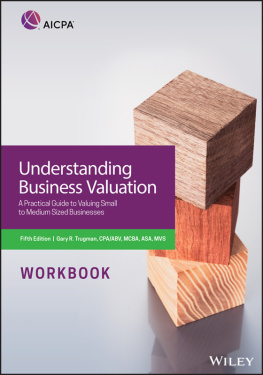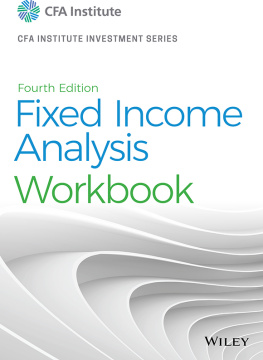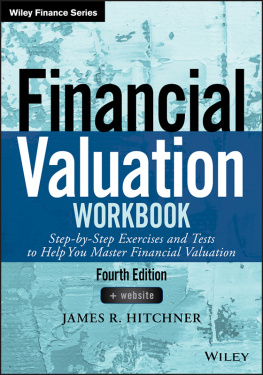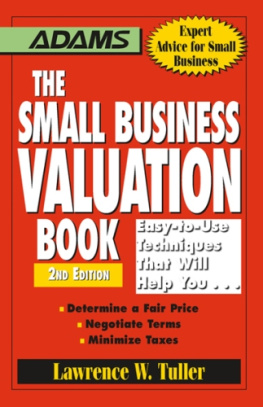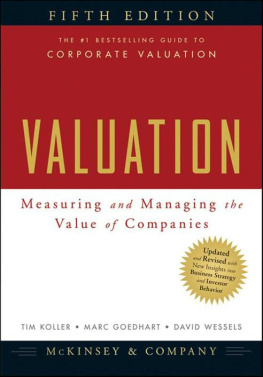
Understanding
Business Valuation
Workbook
A Practical Guide to Valuing Small to
Medium Sized Businesses
GARY TRUGMAN, CPA/ABV,
MCBA, ASA, MVS
Notice to Readers
Understanding Business Valuation Workbook: A Practical Guide to Valuing Small to Medium Sized Businesses does not represent an official position of the American Institute of Certified Public Accountants, and it is distributed with the understanding that the author and publisher are not rendering legal, accounting, or other professional services in the publication. If legal advice or other expert assistance is required, the services of a competent professional should be sought.
Copyright 2018 by
American Institute of Certified Public Accountants, Inc.
New York, NY 10036-8775
All rights reserved. For information about the procedure for requesting permission to make copies of any part of this work, please email with your request. Otherwise, requests should be written and mailed to the Permissions Department, AICPA, 220 Leigh Farm Road, Durham, NC 27707-8110.
ISBN 978-194549-895-4 (paper)
ISBN 978-1-119-53375-7 (ePDF)
ISBN 978-194549-896-1 (ePUB)
Preface
The Understanding Business Valuation Workbook contains educational exercises that are intended to assist the student in enhancing the learning objectives of the chapters from the main textbook. The various exercises contained in this workbook should permit the student to test his or her knowledge based on the materials contained in each chapter.
There are also case studies included in this workbook that can be used to test the information learned and analytical skills of the student by applying theory from the textbook to a particular set of circumstances. And finally, there are exercises that are based on the students research and analytical skills using many of the resources discussed in the textbook.
The importance of this workbook cannot be overemphasized. This is the best way to test your level of knowledge about the topics covered in Understanding Business Valuation. If you do not arrive at the suggested solution, work through the numbers again to see where you went wrong.
As much as I hate to do this, I have also included homework problems in each chapter that either your professor may want to assign to the class or that you may want to tackle on your own as an additional learning experience. You can never learn too much, so have at it!
To get the most out of this workbook, do not cheat by looking up the answers before you have completed the exercises. I know that it is tempting, but the only way that you can know that you learned something from reading all of my hard work is for you to be intellectually honest. Plus, if you have to pass an examination in school or the Accredited in Business Valuation (ABV) examination, do you really think that cheating is going to help you in the long run? I do not think so!
There is one more thing that I hate to do to you, but I have to state that I have provided suggested solutions to the questions and case studies but not to the homework problems. What that means is that there may be other ways to come up with a solution that may be different from those that I have suggested. If you learned nothing else from reading the textbook, you should be clear about the fact that business valuation is a highly subjective process. This means that we can reach different answers for the same question. Of course, mine will be right (only kidding). However, I am using this workbook to enhance your learning experience so I will avoid the more controversial stuff.
Finally, this workbook is divided into the same topical chapters as the main textbook. The last chapter (Chapter 28) in this workbook contains a major case study that will take the student from the start of the engagement through the reconciliation process in determining a conclusion of value. It is intended to allow your instructor to use this as he or she sees fit. There are various appendices that will have to be downloaded at the appropriate time, and your instructor has the suggested solutions.
Have fun with this.
CHAPTER 1
Overview of Business Valuation
The purpose of this chapter was to give you a very brief history of the valuation profession, explain why businesses are valued, provide some background about who values businesses, and familiarize you with professional valuation organizations.
- In developing a buy-sell agreement provision for the withdrawal of an owner of a closely held business interest, the best basis for the buyout price is:
- A price provision designated in the agreement.
- A formula designated in the agreement.
- A valuation done by a qualified valuation analyst.
- A set of terms recommended by an attorney.
- In which of the following valuation assignments is it not likely that valuations as of multiple dates would be performed?
- Divorce.
- Gift tax.
- Damages litigation.
- Employee stock ownership plans.
- Which of the following statements is incorrect?
- Business valuations are performed for companies and interests of all sizes and types.
- The level of data available for the valuation of small and mid-size companies tends to be less than the amount of data available for larger companies.
- The conceptual valuation principles are different for companies of different sizes.
- Having less data creates a larger risk of not being able to interpret the existing data properly.
- Which of the following is a disadvantage of a CPA who performs business valuations?
- Accountants are educated in financial concepts and terminology.
- Accountants are used to working with financial statements and concepts that are either GAAP-oriented or tax-oriented.
- Accountants are frequently exposed to revenue rulings and tax laws.
- Accountants are skilled in working with numbers.
- Which organization promulgated the Uniform Standards of Professional Appraisal Practice (USPAP)?
- The American Institute of Certified Public Accountants (AICPA).
- The American Society of Appraisers.
- The Appraisal Foundation.
- The National Association of Certified Valuation Analysts.
- Which of the following statements is incorrect?
- The purpose of the valuation will influence the standard of value, the methodologies used, the level of research performed, and possibly the date of valuation.
- Valuing smaller businesses can be extremely challenging because most of the empirical data that is regularly used by a valuation analyst applies to larger companies and only tangentially applies to smaller ones.
- The level of data available for the valuation of small and mid-sized companies tends to be greater than the amount of data available for larger companies.
- It is imperative that the valuation analyst understand the purpose of the assignment before the process can begin.
- Which of the following is not a group that generally performs business valuation services?
- Attorneys.
- Accountants.
- College professors.
- Investment bankers.
- To obtain the accreditation of ABV, a candidate must complete all of the following except:
- Be a member in good standing of the AICPA.
- Hold a valid and unrevoked CPA certificate or license.
Next page
